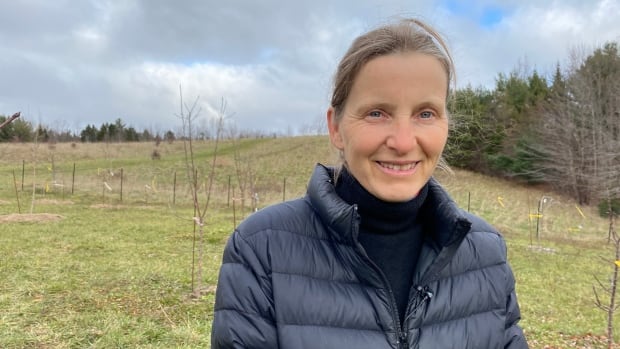In a large greenhouse just outside Lunenburg, N.S., hundreds of unusual plants of all shapes and sizes are getting used to their new life in Nova Scotia.
There are hardy citrus trees from Japan called flying dragon, pineapple guavas with petals that taste like marshmallows and something called a blue sausage tree that has rows of black seeds surrounded by jelly inside.
“And then there’s also things that aren’t even discovered yet, right?” said the woman tending the plants, Annette Clarke. “We always think we know it all, but there’s so many fruit out there I’ve never heard of.”
Clarke transplanted her exotic fruit nursery from the West Coast to the East Coast in May 2021, filling her moving truck with hundreds of plants that are now spending the winter in her 24-by-12-metre greenhouse.
WATCH | Explore an exotic fruit nursery:
From blue ice-cream bananas to yuzu, this Lunenburg, N.S., fruit grower loves the unusual. Take a walk through her exotic fruit greenhouse.
She has more than 65 different varieties and specializes in “easy exotics” that can withstand up to –12 C, or even –20 C. Clarke hopes to show Nova Scotians that even the most unusual plants can find a home here.
“You don’t have to bring things in from far away so you can grow it locally, which is great, right?” she said. “It cuts down on the carbon footprint, too.”
Clarke is an environmentalist who used to restore wetlands before turning her attention to growing her own food.
She transformed her hobby farm on B.C.’s Sunshine Coast, located north of Vancouver, into one of the area’s few exotic nurseries. But she decided to leave the province in part because of the worsening effects of climate change, including the rising number of forest fires.

In her quest to find ever more unusual fruit, Clarke collects seeds and clippings from all over. Some come from botanical gardens or from trips to visit family in Germany, where she grew up. Others she gets from wholesalers who specialize in exotic varieties.
“I just love reading and doing research so I just got all those different plant books about unusual fruit and I was like, ‘Oh that sounds interesting and where could I get it?'” she said.
Her very first exotic plant was a pawpaw, a species native to eastern North America that’s about the size of a mango. It tastes like a mix between a banana and a mango.
Clarke now has everything from yuzu to olive trees.

Her latest obsession is the ice cream banana, which “have a blue-purple colour and they taste like ice cream, like they’re really sweet and fluffy.”
These are fruits that the executive director of the Nova Scotia Fruit Growers’ Association said she hasn’t found at other plant nurseries in the province. The association, which represents more than 50 growers, as well as packers and processors, deals typically with apples, pears, plums, cherries and peaches.
“Any opportunity to increase the market share and to find alternative crops for farms to grow … we should be doing that,” Emily Lutz said. “I think it’s exciting when people take on something new in this province.”
Lutz said peaches are now the second biggest crop of tree fruit in Nova Scotia after apples.
“There may be appetite to move more toward peaches in the future because of the warm days that are coming, and the warming climate,” she added.
Since Clarke began posting online about her nursery near Lunenburg she said she’s been overwhelmed by the response.
When she officially opens in the spring, she plans to hold tasting events and workshops about growing exotic plants and passive-solar greenhouse construction.
She’s building an off-grid greenhouse, as well as an attached tiny home on wheels that will share heat from the sun and a wood stove.

“I wouldn’t say everyone to go ahead [and] buy [a] $100,000 greenhouse, have your fruit cheaper, but you can do it on a much smaller scale,” Clarke said.
For now, her many plants are largely kept inside the greenhouse but she plans to move some outdoors as she works to create “a food forest” with exotic trees on her large property.

She can trace her passion for fruit back to her grandmother, who cherished it as a treat during the Second World War, and then to her own childhood in Germany.
“We had a few times where we didn’t have any money and we had to actually do dumpster diving and we picked fruit from other people’s trees,” she said. “Fruit was this one staple I always loved.”
Clarke refers to her plants as her babies, and feels protective of the vast number of varieties she’s collected over the years.
“I just have the responsibility when I have them, they’re dependent on me and I have to take care of them.”



